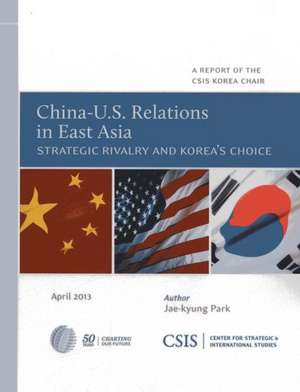China-U.S. Relations in East Asia: CSIS Reports
Autor Jae-Kyung Parken Limba Engleză Paperback – 7 iun 2013
Din seria CSIS Reports
-
 Preț: 256.38 lei
Preț: 256.38 lei -
 Preț: 367.09 lei
Preț: 367.09 lei -
 Preț: 359.82 lei
Preț: 359.82 lei -
 Preț: 200.54 lei
Preț: 200.54 lei -
 Preț: 361.92 lei
Preț: 361.92 lei -
 Preț: 292.06 lei
Preț: 292.06 lei -
 Preț: 290.43 lei
Preț: 290.43 lei -
 Preț: 289.79 lei
Preț: 289.79 lei -
 Preț: 198.19 lei
Preț: 198.19 lei -
 Preț: 322.10 lei
Preț: 322.10 lei -
 Preț: 56.69 lei
Preț: 56.69 lei -
 Preț: 307.87 lei
Preț: 307.87 lei -
 Preț: 320.93 lei
Preț: 320.93 lei -
 Preț: 433.87 lei
Preț: 433.87 lei -
 Preț: 416.40 lei
Preț: 416.40 lei -
 Preț: 383.82 lei
Preț: 383.82 lei -
 Preț: 430.97 lei
Preț: 430.97 lei -
 Preț: 229.04 lei
Preț: 229.04 lei -
 Preț: 381.86 lei
Preț: 381.86 lei -
 Preț: 321.90 lei
Preț: 321.90 lei -
 Preț: 380.94 lei
Preț: 380.94 lei -
 Preț: 380.17 lei
Preț: 380.17 lei -
 Preț: 447.35 lei
Preț: 447.35 lei -
 Preț: 320.93 lei
Preț: 320.93 lei -
 Preț: 365.03 lei
Preț: 365.03 lei - 23%
 Preț: 585.06 lei
Preț: 585.06 lei -
 Preț: 413.02 lei
Preț: 413.02 lei -
 Preț: 380.35 lei
Preț: 380.35 lei -
 Preț: 384.96 lei
Preț: 384.96 lei -
 Preț: 384.21 lei
Preț: 384.21 lei -
 Preț: 336.66 lei
Preț: 336.66 lei -
 Preț: 323.64 lei
Preț: 323.64 lei -
 Preț: 438.67 lei
Preț: 438.67 lei -
 Preț: 392.60 lei
Preț: 392.60 lei -
 Preț: 392.05 lei
Preț: 392.05 lei -
 Preț: 447.35 lei
Preț: 447.35 lei -
 Preț: 320.93 lei
Preț: 320.93 lei -
 Preț: 431.96 lei
Preț: 431.96 lei -
 Preț: 393.74 lei
Preț: 393.74 lei -
 Preț: 449.64 lei
Preț: 449.64 lei -
 Preț: 393.74 lei
Preț: 393.74 lei -
 Preț: 505.90 lei
Preț: 505.90 lei -
 Preț: 391.83 lei
Preț: 391.83 lei -
 Preț: 450.80 lei
Preț: 450.80 lei -
 Preț: 392.05 lei
Preț: 392.05 lei -
 Preț: 448.89 lei
Preț: 448.89 lei -
 Preț: 389.67 lei
Preț: 389.67 lei -
 Preț: 409.10 lei
Preț: 409.10 lei -
 Preț: 393.74 lei
Preț: 393.74 lei
Preț: 413.98 lei
Nou
Puncte Express: 621
Preț estimativ în valută:
79.22€ • 82.88$ • 65.80£
79.22€ • 82.88$ • 65.80£
Carte tipărită la comandă
Livrare economică 03-17 aprilie
Preluare comenzi: 021 569.72.76
Specificații
ISBN-13: 9781442224674
ISBN-10: 1442224673
Pagini: 40
Dimensiuni: 213 x 272 x 20 mm
Greutate: 0.59 kg
Editura: Rowman & Littlefield
Seria CSIS Reports
ISBN-10: 1442224673
Pagini: 40
Dimensiuni: 213 x 272 x 20 mm
Greutate: 0.59 kg
Editura: Rowman & Littlefield
Seria CSIS Reports
Notă biografică
Descriere
At the beginning of the 1990s, China intensified its Asia policy. While the United States was waging a war on terrorism in the Middle East, China tried to engage countries in Asia through its diplomatic "charm offensive" or "smile diplomacy." However, since President Barack Obama took office in 2008, the United States has shown interest in Asia with renewed vigor.
